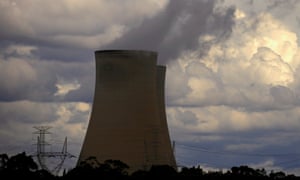Coal mining and coal-fired power use about 383bn litres a year, roughly equivalent to needs of 5.2 million people
The coal industry in New South Wales and Queensland is using as much water as all of Sydney’s households, according to new research.
A new report by University of Adelaide water resources academic Ian Overton, commissioned by the Australian Conservation Foundation, used public data to examine the impact of coal mining and coal-fired power on water resources.
It finds the amount of water consumed by coal mining and coal-fired power in NSW and Queensland is about 383bn litres a year, roughly equivalent to the household water needs of 5.2 million people.
The report finds the amount of freshwater withdrawn from water
resources for the coal industry each year in those states is 2,383bn
litres. About 1,970bn litres of this water is released back into the
environment but, the report says, often it has been polluted or
processed in such a way that it is harmful to fish, plants and other
species.A new report by University of Adelaide water resources academic Ian Overton, commissioned by the Australian Conservation Foundation, used public data to examine the impact of coal mining and coal-fired power on water resources.
It finds the amount of water consumed by coal mining and coal-fired power in NSW and Queensland is about 383bn litres a year, roughly equivalent to the household water needs of 5.2 million people.
The research says the amount of water used by coal-fired power is 120 times the amount of water used by wind or solar.
To produce the figures, Overton drew on water use data from 39 annual reports from 2018 for NSW coal mines to calculate an estimated total water use figure for coal mining in NSW and Queensland. For coal-fired power stations he used data from a 2009 academic report.
He said one of the problems in trying to calculate the amount of water used by the coal industry was there was a lack of consistent and freely available current data. As a result some of the figures were likely to be an underestimate.
One of the report’s recommendations is for improved oversight of water use by the coal industry and more transparent reporting.
Overton said in NSW mining companies often only reported on “components” of their water use, not on all of it, and in Queensland “there was no data on water use in coal mines freely available”. The reports that were available often used different formats and there was no holistic oversight by a single government agency.
“Research was based on available information and the evidence suggests the true impact of coal activities on Australia’s water resources is not well known and is likely underestimated due to a lack of transparency and current regulatory frameworks,” the report states.
“The lack of data, in particular, is a significant challenge to understanding the true impact of coal mining and coal-fired power on Australia’s water resources.”
The report highlights the fact that as Australia’s coal mining activities are concentrated in particular areas, such as NSW’s Hunter region or the Bowen Basin in Queensland, the impact of water use in these areas would be more significant.
Kelly O’Shanassy, the chief executive of the Australian Conservation Foundation, said the intent of the research was to highlight the impact of the coal industry’s water use on a dry continent like Australia, and also to draw attention to gaps in data.
“While farmers recover from the last devastating drought and prepare for the next, each year the coal industry uses as much freshwater as every household in Queensland or the entire population of Sydney,” she said.
“When you add coal-fired electricity’s water consumption and contamination to its climate pollution, it’s clear Australia should rapidly replace coal-fired power with clean energy.
“Becoming a modern renewable energy nation will enable us to weather future shocks and become a safer, more sustainable and resilient country.”

No comments:
Post a Comment